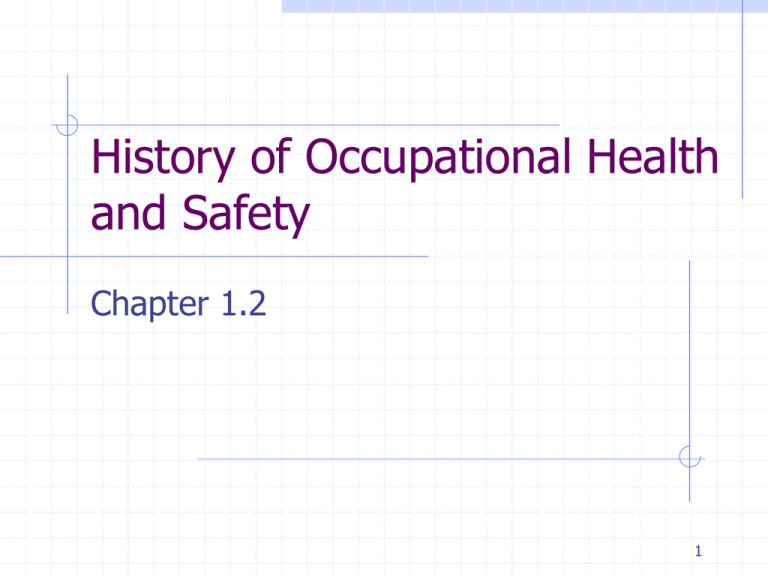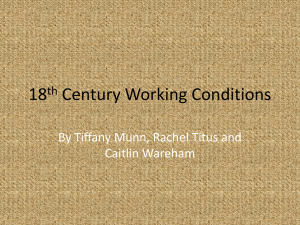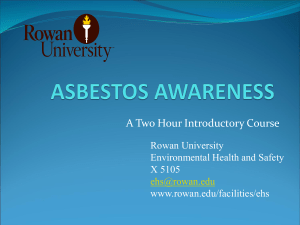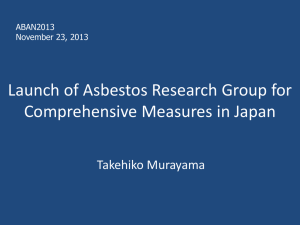Ch 1-2 History OH&S
advertisement

History of Occupational Health and Safety Chapter 1.2 1 Early History of OH&S Code of Hammurabi: Ruler of Babylonians - 2000 BC Early attempt at Worker’s Compensation Payment for damages for injured worker 1500 BC Pharaoh Ramses created industrial medical service for workers Romans created sewage systems, ventilation 2 Example of Hammurabi Laws (example, do not copy) If any one be too lazy to keep his dam in proper condition, and does not so keep it; if then the dam break and all the fields be flooded, then shall he in whose dam the break occurred be sold for money, and the money shall replace the corn which he has caused to be ruined. 3 Pre-Industrial Revolution 1500’s: mining concerns (eg: increased ventilation) 1700’s Ramazzini: founder of occupational and industrial medicine He made the connection between jobs and why people were sick or injured 4 Industrial Revolution started in the 1800’s in Britain changed the way the world produced goods children 8 years old worked in factories over 12 hours. no laws to support health and safety of workers so factory work was dangerous. 5 Industrial Revolution Steam power invented Machines instead of people New methods increased injury Specialization of work: boring so not paying attention Child labour increased (long hours, unhealthy and unsafe conditions). 6 Hazards during the Industrial Revolution (do not copy) Machinery was not always fenced off workers were exposed to moving parts of machines Children moved between machines as they were small enough to fit Mortality (death) rates were high Exhaustion meant more accidents 7 Lack of Reform (do not copy) Reforms would cost owners money and give the workers more rights They wanted to make as much profit as possible (purpose of manufacturing in a capitalist country). First Factory Act in 1819 limited working hours for children to 12 hours Organized protest forced owners to correct some of the worst abuses. 8 Early Growth of Safety Movement Between 1860’s and early 1900’s: Factory Inspection introduced Employer’s Liability Law Government department created for accident investigation Worker’s Compensation Laws passed National Safety Council created 9 Factory Inspection 1860’s factory inspections began restricted child labor and hours of work, clean conditions, safety devices and standards, minimum wages. Factory inspection includes examination of payrolls and employment records; issue fines for unsafe practices. 10 Role of Organized Labour Let public know about bad working conditions Fought for safer working conditions and compensation for injured workers Overturned anti-labour laws: Fellow Servant Rule Contributory Negligence Assumption of Risk 11 Anti-labour Laws Fellow Servant Rule: Employers were not liable for workplace injures that resulted from the negligence of other employees. Contributory Negligence: If the action of employees contributed to their own injuries, the employers weren’t responsible. Assumption of risk: Accept a job; Assume the risks 12 Role of Specific Health Problems Takes tragedies to improve workers’ safety and health Coal Mine Health and Safety Act created in 1969 after explosion killed 78 in Virginia Mercury poisoning stopped the use of the chemical in hat-making Fibers of asbestos causes lung cancer. Removing asbestos now specialized job. 13 Accident Prevention Program World War II: labour shortages, so couldn’t afford to lose workers in accidents. Development of 3 E’s of Safety Enforcement workers obey rules and practices Education: what, when, where, why, how of safety Engineering: better products and process 14 Development of 3 E’s of Safety Enforcement workers obey rules and practices Education: what, when, where, why, how of safety Engineering: better products and process 15 Further Growth of OH&S Awareness 1950’s, steady growth in safety awareness 1960s legislation promoting workplace safety passed. However, work injuries and death were still high. 1970 Occupational Safety and Health Act (OSHA) 1970 Canada Labour Code 1977 Federal Mine Safety Act 1978 Occupational Health and Safety Act 16 NL Newfoundland Significant events changed face of OH&S in Newfoundland and Labrador St. Lawrence: industrial disease due to mining Baie Verte: open pit mining of asbestos Miners went on strike because of OH&S issues (unusual today to strike over safety issues) Ocean Ranger: Oil rig disaster 17 Integrated Approach Today, Health and Safety professionals work together to identify predict control correct health and safety problems 18 Group Assignment: Research one of the three NL tragedies. Then: 1. Submit a one page summary of the event and the influence of, or lack of, adequate OH&S measures. 2. Create a poster (bristol board) representation of your project showing how things were and how they may or may not have improved. 3. Prepare a 3-5 min presentation on you topic and look at how safety has changed since. 19 You can use www.cbc.ca/archives to help gather information on the NL tragedies. The Ocean Ranger: http://archives.cbc.ca/IDD-1-70349/disasters_tragedies/extreme_weather/oc ean_ranger/ Asbestos: Magic Mineral or Deadly Dust? http://archives.cbc.ca/IDD-1-75608/science_technology/asbestos/ To gather information, you can pick audio/video clips to preview and make notes on. Then you can use your clip summaries to write your report. 20









![A Cell is like a Factory[1]](http://s2.studylib.net/store/data/005446661_1-d01b8e928fa376b098eca9080626c037-300x300.png)

